Non-Commercial Grapevines Hybrids Fruits as a Novel Food of High Antioxidant Activity
Abstract
:1. Introduction
2. Materials and Methods
2.1. Reagents and Chemicals
2.2. Hybrid Vine Varieties and Environmental Conditions of Cultivation Environmental Conditions
2.3. Preparation of Extracts for Analysis
2.4. Determination of Total Phenolic Compounds
2.5. Determination of Antioxidant and Oxidoreductive Activities
2.5.1. DPPH Test
2.5.2. ABTS Test
2.5.3. FRAP Test
2.6. Measurement of Total Flavonoid Content
2.7. Measurement of Total Anthocyanin Content
2.8. Measurement of Reducing Sugar Content
2.9. Identification and Quantification of Polyphenolic Compounds by the LC-MS-PDA–Q/TOF and UPLC-PDA Methods
2.10. Statistical Analysis
3. Results and Discussion
3.1. Antioxidant and Oxidoreductive Activities of the Hybrid vines Fruit Fraction Studied
3.1.1. DPPH Assay
| Fraction | Alwood | Beta | Michigan | Minnesota | V 68021 | Variety | Fraction | Variety × Fraction | |
|---|---|---|---|---|---|---|---|---|---|
| DPPH [TE] | |||||||||
| skins | [mg/g f.m.] | 3.31 ± 0.06 a | 4.34 ± 0.06 d | 4.18 ± 0.02 cd | 3.99 ± 0.10 c | 3.60 ± 0.13 b | ns | *** | ns |
| pulp | 1.80 ± 0.03 bc | 1.77 ± 0.03 b | 1.89 ± 0.01 c | 1.84 ± 0.01 bc | 1.59 ± 0.08 a | ||||
| juice | [mg/mL] | 2.06 ± 0.51 a | 1.90 ± 0.45 a | 1.98 ± 0.48 a | 2.06 ± 0.42 a | 1.92 ± 0.45 a | |||
| ABTS [TE] | |||||||||
| skins | [mg/g f.m.] | 2.36 ± 0.05 a | 6.60 ± 0.12 d | 5.73 ± 0.09 c | 5.60 ± 0.13 c | 4.68 ± 0.12 b | *** | *** | *** |
| pulp | 0.42 ± 0.00 b | 1.05 ± 0.01 d | 0.58 ± 0.01 c | 0.59 ± 0.01 c | 0.34 ± 0.01 a | ||||
| juice | [mg/mL] | 2.46 ± 0.02 a | 2.47 ± 0.03 a | 2.50 ± 0.01 a | 2.48 ± 0.03 a | 2.45 ± 0.05 a | |||
| FRAP [FeSO4−2] | |||||||||
| skins | [mg/g f.m.] | 4.08 ± 0.15 d | 2.33 ± 0.23 a | 2.92 ± 0.23 bc | 2.85 ± 0.21 b | 3.42 ± 0.16 c | *** | *** | *** |
| pulp | 0.07 ± 0.01 a | 0.17 ± 0.02 b | 0.22 ± 0.00 c | 0.09 ± 0.01 a | 0.10 ± 0.01 a | ||||
| juice | [mg/mL] | 0.13 ± 0.00 a | 0.16 ± 0.01 b | 0.15 ± 0.01 ab | 0.13 ± 0.01 a | 0.16 ± 0.01 b | |||
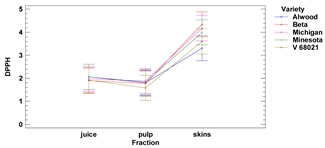 | 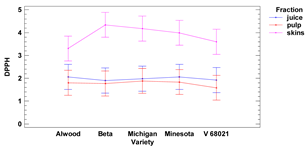 | ||||||||
 | 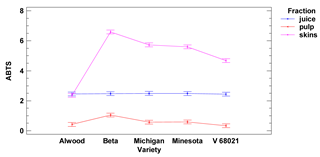 | ||||||||
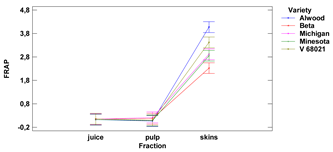 |  | ||||||||
3.1.2. ABTS Assay
3.1.3. FRAP Assay
3.2. Polyphenolics, Flavonoids and Anthocyanins Content of the Hybrid Vines Fruit Fraction Studied
3.2.1. Total Polyphenolic Compounds Content (TPC)
3.2.2. Total Flavonoid Content (TFC)
3.2.3. Total Anthocyanin Content (TAN)
3.3. Total Content of Reducing Sugars (GLUE and FRUE)
3.4. Analysis of Phenolic Compounds by Thin-Layer Chromatography Coupled with Mass Spectrometry (LC-MS-PDA)
4. Conclusions
Author Contributions
Funding
Data Availability Statement
Acknowledgments
Conflicts of Interest
References
- Hokkanen, J.; Mattila, S.; Jaakola, L.; Pirttilaä, A.M.; Tolonen, A. Identification of phenolic compounds from lingonberry (Vaccinium vitis-idaea L.), bilberry (Vaccinium myrtillus L.) and hybrid bilberry (Vaccinium x intermedium Ruthe L.) leaves. J. Agric. Food Chem. 2009, 57, 9437–9447. [Google Scholar] [CrossRef] [PubMed]
- Balanov, P.E.; Smotraeva, I.V.; Abdullaeva, M.S.; Volkova, D.A.; Ivanchenko, O.B. Study on resveratrol content in grapes and wine products. E3S Web Conf. 2021, 247, 01063. [Google Scholar] [CrossRef]
- Goloshvili, T.; Akhalkatsi, M.; Badridze, G.; Kikvidze, Z. Tocopherol contents and antioxidant activity in grape pomace after fermentation and alcohol distillation. Cell. Mol. Biol. 2021, 67, 112–115. [Google Scholar] [CrossRef] [PubMed]
- Benbouguerra, N.; Hornedo-Ortega, R.; Garcia, F.; El Khawand, T.; Saucier, C.; Richard, T. Stilbenes in grape berries and wine and their potential role as anti-obesity agents: A review. Trends Food Sci. Technol. 2021, 112, 362–381. [Google Scholar] [CrossRef]
- Rasines-Perea, Z.; Teissedre, P.L. Grape polyphenols’ effects in human cardiovascular diseases and diabetes. Molecules 2017, 22, 68. [Google Scholar] [CrossRef]
- Campos, F.; Peixoto, A.F.; Fernandes, P.A.R.; Fernandes, I.; Fernandes, A. The antidiabetic effect of grape pomace polysaccharide-polyphenol complexes. Nutrients 2021, 13, 4495. [Google Scholar] [CrossRef]
- Freire, D.R.G.C.; Cassiano, C.Z.D.C.; Soares, K.L.; Lemos, M.F.; Pimentel-Schmitt, E.F.; Fronza, M.; Endringer, D.C.; Scherer, R. Cancer chemopreventive and antioxidant activities of seed, skin, and pulp of Maximo hybrid grapes (IAC 138-22) at five different ripening stages. Cienc. Rural 2022, 52. [Google Scholar] [CrossRef]
- Ghazzawi, H.A.; Al-Sayyed, H.F.; Al-Kurd, R.A.; Arafat, T.A.; AbdelQader, S.M. Effect of different extraction solvents on the antioxidant content and capacity of nine seasonal fruits. Clin. Nutr. 2021, 38, 33–42. [Google Scholar] [CrossRef]
- Akyuz, M.; Yabo-Dambagi, L.; Kilic, T.; Cakir, A. Antidiabetic, neuroprotective and antioxidant potentials of different parts of Pistacia terebinthus fruits. S. Afr. J. Bot. 2022, 147, 443–456. [Google Scholar] [CrossRef]
- Yen, G.C.; Chen, H.Y. Antioxidant activity of various tea extracts in relation to their antimutagenicity. J. Agric. Food Chem. 1995, 43, 27–32. [Google Scholar] [CrossRef]
- Klymenko, S.; Kucharska, A.Z.; Sokół-Łętowska, A.; Piórecki, N. Antioxidant activities and phenolic compounds in fruits of cultivars of cornelian cherry (Cornus mas L.). Agrobiodivers. Improv. Nutr. Health Life Qual. 2019, 3, 484–499. [Google Scholar] [CrossRef]
- Sridhar, K.; Charles, A.L. In vitro antioxidant activity of Kyoho grape extracts in DPPH and ABTS assays: Estimation methods for EC50 using advanced statistical programs. Food Chem. 2019, 275, 41–49. [Google Scholar] [CrossRef] [PubMed]
- Re, R.; Pellegrini, N.; Proteggente, A.; Pannala, A.; Yang, M.; Rice-Evans, C. Antioxidant activity applying an improved ABTS radical cation decolorization assay. Free Radic. Biol. Med. 1999, 26, 1231–1237. [Google Scholar] [CrossRef]
- Chang, C.; Yang, M.; Wen, H.; Chern, J. Estimation of total flavonoid content in propolis by two complementary colometric methods. J. Food Drug Anal. 2002, 10, 178–182. [Google Scholar] [CrossRef]
- Giusti, M.M.; Wrolstad, R.E. Characterization and measurement of anthocyanins by UV–visible spectroscopy. Curr. Protoc. Food Anal. Chem. 2001, 683–695. [Google Scholar] [CrossRef]
- Miller, G.L. Use of dinitrosalicylic acid reagent for determination of reducing sugar. Anal. Chem. 1959, 31, 426–428. [Google Scholar] [CrossRef]
- Wojdyło, A.; Nowicka, P. Profile of phenolic compounds of Prunus armeniaca L. leaf extract determined by LC-ESI-QTOF-MS/MS and their antioxidant, anti-diabetic, anti-cholinesterase, and anti-inflammatory potency. Antioxidants 2021, 10, 1869. [Google Scholar] [CrossRef]
- de la Fuente Lloreda, M. Use of hybrids in viticulture. A challenge for the OIV. Oeno One 2018, 52, 231–234. [Google Scholar] [CrossRef]
- Rätsep, R.; Karp, K.; Maante-Kuljus, M.; Aluvee, A.; Bhat, R. Polyphenols and resveratrol from discarded leaf biomass of grapevine (Vitis sp.): Effect of cultivar and viticultural practices in Estonia. Agriculture 2020, 10, 393. [Google Scholar] [CrossRef]
- Miguel, C.A.; Noya-Riobó, M.V.; Mazzone, G.L.; Villar, M.J.; Coronel, M.F. Antioxidant, anti-inflammatory and neuroprotective actions of resveratrol after experimental nervous system insults. Special focus on the molecular mechanisms involved. Neurochem. Int. 2021, 150, 105188. [Google Scholar] [CrossRef]
- Kubyshkin, A.; Shevandova, A.; Petrenko, V.; Fomochkina, I.; Sorokina, L.; Kucherenko, A. Anti-inflammatory and antidiabetic effects of grape-derived stilbene concentrate in the experimental metabolic syndrome. Diabetes Metab. Disord. 2020, 19, 1205–1214. [Google Scholar] [CrossRef] [PubMed]
- Mattei, L.; Francisqueti-Ferron, F.V.; Garcia, J.L.; Ferron, A.J.T.; de Almeida Silva, C.C.V.; Gregolin, C.S. Antioxidant and anti-inflammatory properties of gamma-oryzanol attenuates insulin resistance by increasing GLUT-4 expression in skeletal muscle of obese animals. Mol. Cell. Endocrinol. 2021, 537, 111423. [Google Scholar] [CrossRef] [PubMed]
- Samoticha, J.; Wojdyło, A.; Golis, T. Phenolic composition, physicochemical properties and antioxidant activity of interspecific hybrids of grapes growing in Poland. Food Chem. 2017, 215, 263–273. [Google Scholar] [CrossRef] [PubMed]
- da Costa, R.R.D.; Ferreira, T.D.O.; de Lima, M.A.C. Training systems, rootstocks and climatic conditions influence quality and antioxidant activity of ‘BRS Cora’grape. Acta Sci. Agron. 2020, 43, 1–12. [Google Scholar] [CrossRef]
- Yilmaz, Y.; Göksel, Z.; Erdoğan, S.S.; Öztürk, A.; Atak, A.; Özer, C. Antioxidant activity and phenolic content of seed, skin and pulp parts of 22 grape (V itis vinifera L.) cultivars (4 common and 18 registered or candidate for registration). J. Food Process. Preserv. 2015, 39, 1682–1691. [Google Scholar] [CrossRef]
- Baiano, A. Phenolic compounds and antioxidant activity of experimental and industrial table grape juices. J. Food Process. Preserv. 2020, 44, e14655. [Google Scholar] [CrossRef]
- Kupe, M.; Karatas, N.; Unal, M.S.; Ercisli, S.; Baron, M.; Sochor, J. Phenolic composition and antioxidant activity of peel, pulp and seed extracts of different clones of the turkish grape cultivar ‘karaerik’. Plants 2021, 10, 2154. [Google Scholar] [CrossRef]
- Lingua, M.S.; Fabani, M.P.; Wunderlin, D.A.; Baroni, M.V. In vivo antioxidant activity of grape, pomace and wine from three red varieties grown in Argentina: Its relationship to phenolic profile. J. Funct. Foods 2016, 20, 332–345. [Google Scholar] [CrossRef]
- Tai, A.; Ohno, A.; Ito, H. Isolation and characterization of the 2,2′-azinobis (3-ethylbenzothiazoline-6-sulfonic acid) (ABTS) radical cation-scavenging reaction products of arbutin. J. Agric. Food Chem. 2016, 64, 7285–7290. [Google Scholar] [CrossRef]
- Jachna, T.J.; Hermes, V.S.; Flôres, S.H.; Rios, A.O. Bioactive compounds in pindo palm (Butia capitata) juice and in pomace resulting of the extraction process. J. Sci. Food Agric. 2016, 96, 1216–1222. [Google Scholar] [CrossRef]
- Donovan, L.A.; Rosenthal, D.R.; Sanchez-Velenosi, M.; Rieseberg, L.H.; Ludwig, F. Are hybrid species more fit than ancestral parent species in the current hybrid species habitats? J. Evol. Biol. 2010, 23, 805–816. [Google Scholar] [CrossRef]
- Peixoto, C.M.; Dias, M.I.; Alves, M.J.; Calhelha, R.C.; Barros, L.; Pinho, S.P.; Ferreira, I.C. Grape pomace as a source of phenolic compounds and diverse bioactive properties. Food Chem. 2018, 253, 132–138. [Google Scholar] [CrossRef] [PubMed] [Green Version]
- Brezoiu, A.M.; Matei, C.; Deaconu, M.; Stanciuc, A.M.; Trifan, A.; Gaspar-Pintiliescu, A.; Berger, D. Polyphenols extract from grape pomace. Characterization and valorisation through encapsulation into mesoporous silica-type matrices. Food Chem. Toxicol. 2019, 133, 110787. [Google Scholar] [CrossRef] [PubMed]
- Cotea, V.V.; Luchian, C.; Niculaua, M.; Zamfir, C.I.; Moraru, I.; Nechita, B.C.; Colibaba, C. Evaluation of phenolic compounds content in grape seeds. Environ. Eng. Manag. J. 2018, 17, 795–803. [Google Scholar] [CrossRef]
- Pfukwa, T.M.; Fawole, O.A.; Manley, M.; Gouws, P.A.; Opara, U.L.; Mapiye, C. Food preservative capabilities of grape (vitis vinifera) and clementine mandarin (Citrus reticulata) by-products extracts in South Africa. Sustainability 2019, 11, 1746. [Google Scholar] [CrossRef] [Green Version]
- Barros, L.B.; May-De Mio, L.L.; Biasi, L.A.; Di Profio, F.; Reynolds, A.G. Use of HPLC for characterization of sugar and phenolic compounds in Vitis labrusca juice. Idesia 2014, 32, 89–94. [Google Scholar] [CrossRef] [Green Version]
- Leong, S.Y.; Burritt, D.J.; Oey, I. Evaluation of the anthocyanin release and health-promoting properties of Pinot Noir grape juices after pulsed electric fields. Food Chem. 2016, 196, 833–841. [Google Scholar] [CrossRef]
- Torchio, F.; Urcan, D.E.; Lin, L.; Gerbi, V.; Giacosa, S.; Segade, S.R.; Rolle, L. Influence of different withering conditions on phenolic composition of Avanà, Chatus and Nebbiolo grapes for the production of ‘Reinforced’wines. Food Chem. 2016, 194, 247–256. [Google Scholar] [CrossRef]
- Romero-Cascales, I.; Ortega-Regules, A.; López-Roca, J.M.; Fernández-Fernández, J.I.; Gómez-Plaza, E. Differences in anthocyanin extractability from grapes to wines according to variety. Am. J. Enol. Vitic. 2005, 56, 212–219. [Google Scholar]
- Ortega-Regules, A.; Romero-Cascales, I.; López-Roca, J.M.; Ros-García, J.M.; Gómez-Plaza, E. Anthocyanin fingerprint of grapes: Environmental and genetic variations. J. Sci. Food Agric. 2006, 86, 1460–1467. [Google Scholar] [CrossRef]
- Tkacz, K.; Wojdyło, A.; Nowicka, P.; Turkiewicz, I.; Golis, T. Characterization in vitro potency of biological active fractions of seeds, skins and flesh from selected Vitis vinifera L. cultivars and interspecific hybrids. J. Funct. Foods. 2019, 56, 353–363. [Google Scholar] [CrossRef]
- Lago-Vanzela, E.S.; Da-Silva, R.; Gomes, E.; García-Romero, E.; Hermosin-Gutierrez, I. Phenolic composition of the edible parts (flesh and skin) of Bordô grape (Vitis labrusca) using HPLC–DAD–ESI-MS/MS. J. Agric. Food Chem. 2011, 59, 13136–13146. [Google Scholar] [CrossRef] [PubMed]
- Vilanova, M.; Rodríguez, I.; Canosa, P.; Otero, I.; Gamero, E.; Moreno, D.; Valdés, E. Variability in chemical composition of Vitis vinifera cv Mencía from different geographic areas and vintages in Ribeira Sacra (NW Spain). Food Chem. 2015, 169, 187–196. [Google Scholar] [CrossRef] [PubMed]
- Liang, N.N.; He, F.; Bi, H.Q.; Duan, C.Q.; Reeves, M.J.; Wang, J. Evolution of flavonols in berry skins of different grape cultivars during ripening and a comparison of two vintages. Eur. Food Res. Technol. 2012, 235, 1187–1197. [Google Scholar] [CrossRef]
| Michigan | 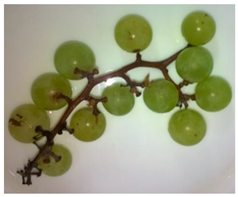 | 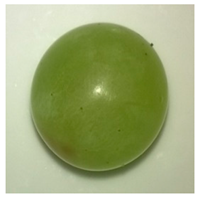 |
| V 68021 | 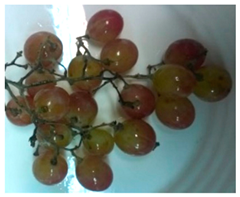 | 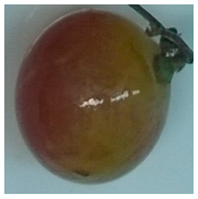 |
| Minnesota | 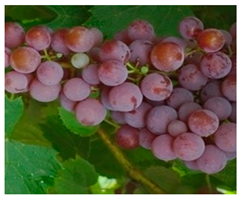 | 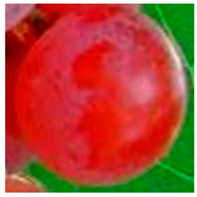 |
| Beta |  |  |
| Alwood | 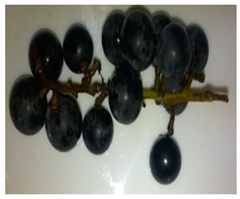 | 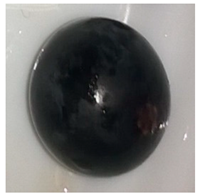 |
| Fraction | Alwood | Beta | Michigan | Minnesota | V 68021 | Variety | Fraction | Variety × Fraction | |
|---|---|---|---|---|---|---|---|---|---|
| TPC [GAE] | |||||||||
| skins | [mg/g f.m.] | 16.33 ± 0.08 e | 2.58 ± 0.16 a | 6.37 ± 0.13 b | 7.39 ± 0.10 c | 8.72 ± 0.18 d | *** | *** | *** |
| pulp | 0.03 ± 0.01 a | 0.02 ± 0.03 a | 0.37 ± 0.01 c | 0.25 ± 0.05 b | 0.30 ± 0.01 b | ||||
| juice | [mg/mL] | 0.02 ± 0.02 a | 0.56 ± 0.10 b | 1.30 ± 0.09 bc | 0.27 ± 0.04 c | 0.48 ± 0.16 d | |||
| TFC [QE] | |||||||||
| skins | [µg/g f.m.] | 251.0 ± 10.0 c | 269.8 ± 12.9 c | 113.2 ± 8.9 a | 172.9 ± 9.8 b | 126.2 ± 11.5 a | *** | *** | *** |
| pulp | 311.2 ± 15.0 c | 310.7 ± 10.9 c | 133.6 ± 11.1 a | 196.1 ± 9.1 b | 179.0 ± 12.9 b | ||||
| juice | [µg/mL] | 34.50 ± 1.84 b | 55.10 ± 2.40 c | 7.60 ± 1.13 a | 30.70 ± 0.99 b | 31.90 ± 0.99 b | |||
| TAN [DE] | |||||||||
| skins | [mg/g f.m.] | 2.38 ± 0.03 e | 2.13 ± 0.04 d | 0.33 ± 0.02 a | 1.18 ± 0.03 c | 1.08 ± 0.03 b | *** | *** | *** |
| pulp | 0.55 ± 0.03 c | 0.55 ± 0.03 c | 0.04 ± 0.03 a | 0.36 ± 0.03 b | 0.44 ± 0.04 b | ||||
| juice | [mg/mL] | 0.12 ± 0.01 c | 0.19 ± 0.01 d | 0.02 ± 0.01 a | 0.09 ± 0.01 b | 0.09 ± 0.01 b | |||
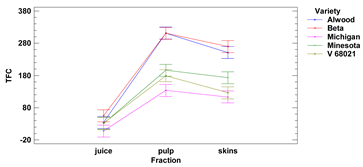 | 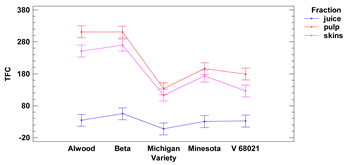 | ||||||||
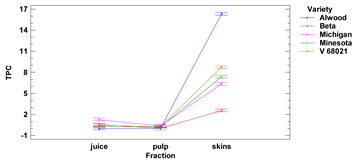 | 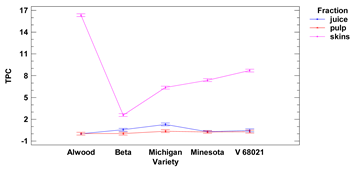 | ||||||||
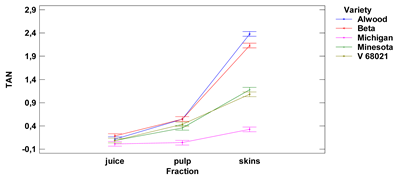 |  | ||||||||
| Glucose [GLUE] | Fructose [FRUE] | |
|---|---|---|
| [g/L] | ||
| Alwood | 7.0 ± 0.5 a | 6.28 ± 0.39 a |
| Beta | 16.7 ± 0.7 b | 13.18 ± 0.59 b |
| Michigan | 38.9 ± 0.3 e | 41.49 ± 1.03 e |
| Minnesota | 26.0 ± 0.5 d | 26.86 ± 0.54 d |
| V 68021 | 20.6 ± 1.0 c | 25.07 ± 0.54 c |
| Compounds | Rt (min) | λmax (nm) | MS [M-H]−(m/z) | MS/MS [M-H]−(m/z) | Kind of Sample |
|---|---|---|---|---|---|
| Anthocyanins | |||||
| Dephinidin-3-O-rutinoside | 4.193 | 522 | 611.14+ | 303.05 | Minnesota—skin; Beta—skin, juice; Alwood—skin, juice |
| Malvidin-3,5-di-O-glucoside | 4.444 | 522 | 655.27+ | 493.11/331.05 | Beta—skin |
| Delphinidin-3-O-(6″-acetyl)-glucoside | 4.724 | 520 | 507.11+ | 303.05 | Beta—skin |
| Delphinidin-3-O-rhamnoside | 4.750 | 522 | 449.02+ | 303.05 | Minnesota—skin; Beta—skin, juice; Alwood—skin, juice |
| Malvidin-3-O-galactoside | 5.281 | 527 | 493.13+ | 331.04 | Beta—skin; Alwood—skin |
| Peonidin-3-O-glucoside | 5.301 | 517 | 463.10+ | 301.07 | Minnesota—skin; Beta—skin, juice; Alwood—skin, juice |
| Peonidin-3-O-rutinoside | 5.433 | 522 | 609.63+ | 301.07 | Beta—skin; Alwood—skin |
| Malvidin-3-O-glucoside | 5.503 | 522 | 493.10+ | 331.04 | Beta—skin |
| Petunidin-3-O-(6″-acetyl)-glucoside | 5.885 | 525 | 521.12+ | 317.07 | Beta—skin, juice; Alwood—skin |
| Malvidin-3-O-(6″-acetyl)-glucoside | 6.971 | 529 | 535.23+ | 331.05 | Beta—skin |
| Malvidin-3-O-(6-O-caffeoyl)-glucoside | 7.320 | 531 | 655.17+ | 331.04 | Beta—skin; Alwood—skin |
| Petunidin-3-O-(6″-p-coumaroyl)-glucoside | 7.593 | 527 | 625.31+ | 317.07 | Beta—skin; Alwood—skin, juice |
| Malvidin-3-O-(6″-p-coumaroyl)-glucoside | 8.592 | 530 | 639.16+ | 331.05 | Beta—skin; Alwood—skin |
| Flavonols | |||||
| Myricetin-3-O-glucoside | 5.596 | 360 | 478.98 | 316.89 | Minnesota—skin; Alwood—skin, juice |
| Myricetin-3-O-rhamnoside | 6.251 | 349 | 464.36 | 316.89 | Michigan—skin, juice |
| Quercetin -3-O-rutinoside | 6.385 | 355 | 609.11 | 300.95 | Minnesota—skin; Michigan—skin, juice; V68021—skin |
| Quercetin-3-O-glucuronide | 6.553 | 354 | 476.95 | 300.95 | Minnesota—skin; Michigan—skin; Alwood—skin, juice |
| Quercetin-3-O-glucoside | 6.581 | 355 | 462.98 | 300.95 | Michigan—skin; Alwood—skin, juice |
| Isorhamnetin-3-O-rutinoside | 7.277 | 355 | 623.08 | 315.01 | Michigan—skin; Alwood—skin |
| Isorhamnetin-3-O-glucoside | 7.526 | 355 | 477.13 | 315.01 | Michigan—skin; Alwood—skin, juice |
| Phenolic acids and stilbenes | |||||
| Gallic acid | 1.386 | 272 | 169.11 | 124.98 | Michigan—skin; Minnesota—pulp; V68021—pulp; |
| Gentisic acid | 2.391 | 327 | 192.99 | 178.98/149.01 | Michigan—pulp, juice; |
| Caftaric acid | 3.160 | 323 | 311.04 | 178.98/149.01 | Michigan—pulp, juice, skin; Minnesota—pulp; V68021—pulp, skin, juice; Beta—pulp, skin, juice; Alwood—pulp, skin, juice |
| Chlorogenic acid | 3.818 | 325 | 353.21 | 191.05 | V68021—pulp; Beta—skin |
| Caffeoyl glucose | 4.089 | 328 | 341.01 | 178.98/160.98/135.00 | Michigan—pulp, skin, juice; Minnesota—pulp, skin, juice; V68021—pulp; |
| Caffeic acid | 4.103 | 323 | 179.07 | 135.00 | Michigan—pulp, skin, juice; Minnesota—pulp, juice; V68021—pulp, juice; Beta—pulp, skin, juice; Alwood—pulp, skin |
| Coutaric acid | 4.822 | 312 | 294.97 | 162.98 | Michigan—pulp, skin, juice; V68021—juice; Beta—skin; Alwood—pulp, skin |
| Fertratic acid | 5.318 | 327 | 325.02 | 192.99/149.01 | Michigan—pulp, skin; V68021—pulp; Alwood—skin |
| Trans-resveratrol | 7.153 | 304 | 227.00 | Michigan—skin, juice; Minnesota—skin, juice; | |
| Flavan-3-ols | |||||
| Procyanidin dimer | 2.819 | 278 | 577.14 | 289.11 | Michigan—skin; V68021—skin, pulp; |
| (+)-catechin | 3.593 | 278 | 289.11 | Michigan—skin, juice; Minnesota—pulp, skin, juice; V68021—pulp, skin, juice; Beta—pulp, skin, juice; Alwood—pulp, skin | |
| Procyanidin dimer | 3.625 | 279 | 578.13 | 289.11 | Michigan—pulp, skin; Minnesota—pulp, skin; V68021—pulp, skin, juice; Alwood—pulp, skin |
| Procyanidin dimer | 4.392 | 280 | 578.13 | 289.11 | Michigan—skin, juice; V68021—juice; Beta—pulp, skin; Alwood—pulp |
| (−)-epicatechin | 4.666 | 278 | 289.11 | Michigan—pulp, skin, juice; Minnesota—skin, juice; V68021—pulp, skin, juice; Beta—pulp, skin, juice; Alwood—pulp, skin, juice | |
| Variety | Fruit Fraction | Anthocyanins [mg/1 kg] | Flavonols [mg/1 kg] | Phenolic Acids and Stilbenes [mg/1 kg] | Flavan-3ols [mg/1 kg] | Total Polyphenols [mg/1 kg] |
|---|---|---|---|---|---|---|
| Michigan | skin | nd | 64.48 ± 6.13 a | 33.96 ± 3.75 b | 37.62 ± 0.48 g | 136.06 ± 10.36 d |
| juice | nd | 8.37 ± 0.02 d | 2.56 ± 0.07 h | 8.82 ± 0.04 k | 19.75 ± 0.13 j | |
| pulp | nd | nd | 2.68 ± 0.06 h | 16.48 ± 0.98 j | 19.16 ± 1.04 j | |
| Minnesota | skin | 11.15 ± 2.42 bc | 15.69 ± 1.01 c | 21.50 ± 0.93 c | 125.02 ± 8.52 c | 173.36 ± 12.88 c |
| juice | nd | nd | 0.45 ± 0.09 k | 22.27 ± 0.10 i | 22.72 ± 0.19 i | |
| pulp | nd | nd | 2.27 ± 0.00 i | 40.75 ± 1.07 f | 43.02 ± 1.07 g | |
| V 68021 | skin | nd | 8.47 ± 0.38 d | 16.89 ± 1.12 d | 158.81 ± 6.27 b | 184.18 ± 7.77 c |
| juice | nd | nd | 2.56 ± 0.24 h | 27.41 ± 1.33 h | 29.97 ± 1.57 h | |
| pulp | nd | nd | 3.38 ± 0.61 g | 85.73 ± 1.41 d | 89.11 ± 2.02 e | |
| Beta | skin | 716.57 ± 11.03 a | nd | 11.21 ± 0.61 e | 86.83 ± 4.15 d | 814.61 ± 15.79 b |
| juice | 8.51 ± 1.02 c | nd | 5.35 ± 0.46 f | 47.15 ± 4.10 e | 61.01 ± 5.59 e | |
| pulp | nd | nd | 5.43 ± 0.73 f | 46.61 ± 0.75 e | 52.04 ± 1.48 f | |
| Alwood | skin | 728.83 ± 9.21 a | 38.81 ± 1.32 b | 43.87 ± 1.96 a | 205.00 ± 11.11 a | 1016.52 ± 23.60 a |
| juice | 14.47 ± 0.32 b | 4.92 ± 0.03 e | 4.49 ± 0.79 f | 25.15 ± 2.11 h | 49.03 ± 3.25 fg | |
| pulp | nd | nd | 2.09 ± 0.04 j | 41.49 ± 1.91 f | 43.58 ± 1.95 g |
Publisher’s Note: MDPI stays neutral with regard to jurisdictional claims in published maps and institutional affiliations. |
© 2022 by the authors. Licensee MDPI, Basel, Switzerland. This article is an open access article distributed under the terms and conditions of the Creative Commons Attribution (CC BY) license (https://creativecommons.org/licenses/by/4.0/).
Share and Cite
Olędzki, R.; Lutosławski, K.; Nowicka, P.; Wojdyło, A.; Harasym, J. Non-Commercial Grapevines Hybrids Fruits as a Novel Food of High Antioxidant Activity. Foods 2022, 11, 2216. https://doi.org/10.3390/foods11152216
Olędzki R, Lutosławski K, Nowicka P, Wojdyło A, Harasym J. Non-Commercial Grapevines Hybrids Fruits as a Novel Food of High Antioxidant Activity. Foods. 2022; 11(15):2216. https://doi.org/10.3390/foods11152216
Chicago/Turabian StyleOlędzki, Remigiusz, Krzysztof Lutosławski, Paulina Nowicka, Aneta Wojdyło, and Joanna Harasym. 2022. "Non-Commercial Grapevines Hybrids Fruits as a Novel Food of High Antioxidant Activity" Foods 11, no. 15: 2216. https://doi.org/10.3390/foods11152216
APA StyleOlędzki, R., Lutosławski, K., Nowicka, P., Wojdyło, A., & Harasym, J. (2022). Non-Commercial Grapevines Hybrids Fruits as a Novel Food of High Antioxidant Activity. Foods, 11(15), 2216. https://doi.org/10.3390/foods11152216








